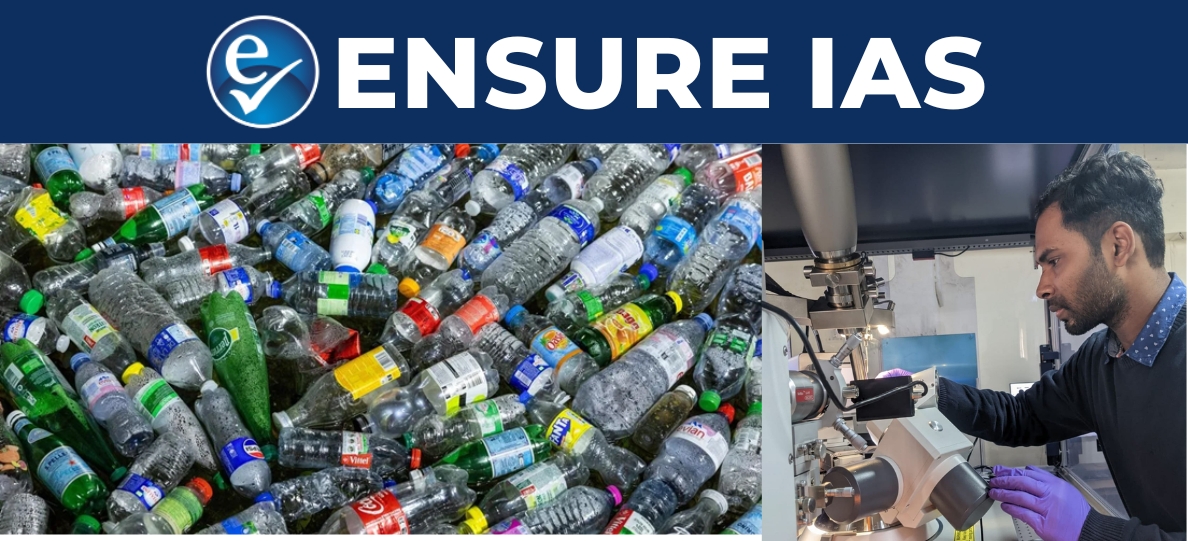- Courses
- GS Full Course 1 Year
- GS Full Course 2 Year
- GS Full Course 3 Year
- GS Full Course Till Selection
- Online Program
- GS Recorded Course
- NCERT (Recorded 500+ Hours)
- Polity Recorded Course
- Geography Recorded Course
- Economy Recorded Course
- AMAC Recorded Course
- Modern India, Post Independence & World History
- Environment Recoded Course
- Governance Recoded Course
- Science & Tech. Recoded Course
- International Relations and Internal Security Recorded Course
- Disaster Management Module Course
- Ethics Recoded Course
- Essay Recoded Course
- Current Affairs Recoded Course
- CSAT
- 5 LAYERED ARJUNA Mentorship
- Public Administration Optional
- ABOUT US
- OUR TOPPERS
- TEST SERIES
- FREE STUDY MATERIAL
- VIDEOS
- CONTACT US
IIT Roorkee's Research on Bacterial Enzymes for Degrading Plasticizers
IIT Roorkee's Research on Bacterial Enzymes for Degrading Plasticizers
14-01-2025

- Plasticizers are chemicals added to plastics to improve their flexibility, durability, and appearance.
- Commonly found in everyday products like baby toys, shampoos, soaps, and food containers.
- One of the most widely used plasticizers is DEHP (Diethylhexyl phthalate), a phthalate compound.
- Health Risks: These chemicals are not only persistent in the environment but also pose significant health risks.
- Carcinogenic: Many plasticizers are harmful, potentially causing cancer and other diseases.
- Skin Absorption: Plasticizers can be absorbed through the skin, especially from products like toys and cosmetics, leading to direct exposure to humans.
- Environmental Concerns: As plasticizers are difficult to break down, their accumulation in the environment has become a growing concern, making it essential to find effective degradation methods.
The Role of IIT Roorkee’s Research:
In January 2025, Department of Biosciences and Bioengineering at IIT Roorkee, developed an innovative method using bacterial enzymes to degrade harmful plasticizers, especially DEHP, found in plastics.
Enzyme Identified: Esterase from Sulfobacillus acidophilus
- Bacterial Enzyme Used: The research focused on the esterase enzyme produced by the soil bacterium Sulfobacillus acidophilus.
- Esterase Enzymes: These enzymes break ester bonds, which are present in plasticizers like phthalates, by catalyzing their hydrolysis (breaking them down into smaller molecules).
- Targeted Plasticizer: The research specifically targeted DEHP, a high molecular weight phthalate ester that is typically harder to degrade.
- DEHP is commonly used in products like PVC plastics, baby products, and cosmetics.
Why is This Discovery Significant?
- While esterase enzymes have been used in the past to degrade low molecular weight phthalates, DEHP is a high molecular weight phthalate, which is much more difficult to break down.
- IIT Roorkee team showed that the esterase enzyme from Sulfobacillus acidophilus can degrade DEHP efficiently, something no other known enzyme has been able to do for high molecular weight phthalates.
- Environmental Solution: By breaking down DEHP into safer substances like 2-ethyl hexanol and MEHP (Mono-(2-ethylhexyl) phthalate), this method could reduce the environmental accumulation of these harmful substances.
How the Esterase Enzyme Works
- Esterase Action: The esterase enzyme acts on DEHP by breaking the ester bonds, converting it into:
- MEHP (Mono-(2-ethylhexyl) phthalate): A less toxic product.
- 2-ethyl hexanol: A non-toxic alcohol.
- Further Degradation: After this initial degradation, the MEHP can be further broken down by other enzymes, eventually resulting in the complete breakdown of the plasticizer into harmless byproducts like water and carbon dioxide.
- Efficiency: The esterase enzyme remains active for about one month, making it highly efficient for continuous degradation over time.
Structural Characterization of the Esterase Enzyme
- The team used X-ray crystallography to map the enzyme's 3D structure, which revealed the active sites responsible for its ability to break down DEHP.
- This allowed the researchers to understand how the enzyme interacts with the plasticizer at a molecular level.
- In addition to crystallography, biochemical and biophysical techniques were used to assess how well the enzyme could break down DEHP, demonstrating its high degradation efficiency.
Scaling Up Production of the Esterase Enzyme
- Gene Cloning: To produce the enzyme in large quantities, the esterase gene was cloned into E. coli bacteria.
- These genetically modified bacteria were cultured using aerobic conditions, allowing for the mass production of the enzyme at a larger scale.
- Sustainability: The ability to produce the enzyme in large quantities ensures that it can be used in practical applications for pollution control and environmental cleanup.
Potential Applications of the Research
-
Pollution Mitigation:
- The esterase enzyme can be used to degrade plasticizers present in polluted water and other environments, especially in water bodies contaminated with plastic waste.
- This method offers a biodegradable solution to reduce plasticizer pollution, which is hard to manage with conventional methods.
- Plastic Recovery: The enzyme can also bind to polypropylene, a common type of plastic, allowing it to extract and remove plastics from contaminated water sources.
- Future Steps: The team is working on combining five different enzymes that break down various stages of plasticizer degradation. This combination would enable a more seamless and faster breakdown process.
- The five enzymes include:
- Esterase enzyme (from Sulfobacillus acidophilus) for initial breakdown.
- Phthalate dioxygenase and phthalate decarboxylase for further breakdown of intermediate compounds.
- Comamonas testosteroni bacteria enzymes for complete mineralization (converting the plasticizer into water and carbon dioxide).
- The five enzymes include:
- By inserting the genes for all 5 enzymes into a single bacterium, the team aims to create a biological system where:
- The enzymes work sequentially to completely degrade DEHP into harmless substances.
- The bacteria, once engineered, will continuously break down the plasticizers without requiring new batches of enzymes.
Enzyme Engineering for Faster Degradation:
- The researchers are conducting enzyme engineering to enhance the performance of these enzymes, making the degradation process more efficient and faster.
- This could help scale the technology for industrial applications, ensuring that the process works well on a larger scale.
Conclusion and Implications of the Research
This research offers a promising solution to the global problem of plastic pollution, especially the harmful impact of plasticizers like DEHP. By using bacterial enzymes to break down these harmful chemicals, it could lead to cleaner environments and healthier ecosystems. Reducing plasticizer contamination in the environment and human products could help mitigate health risks related to cancer and other diseases caused by exposure to toxic chemicals.
|
Also Read |
|
| FREE NIOS Books | |




